| This is a portion of the intranet Web Documentation I created for MIT's Media Laboratory in 1995--1996. |
![[STRUCTURE]](net-structure.gif)
![[DEVICES]](net-devices.gif)
![[CONNECTORS]](net-connect.gif)
![[HOOKUPS]](net-hookups.gif)
[Structure] | [Devices]
| [Connectors] | [Hookups]
The Overall Structure of the Network at The Media Lab is best described as"A Star of Star of Stars".The central hub of the Network is the Master Distribution Frame. Massive vertical trunks run from the MDF to three Intermediate Distribution Frames. Horizontal Trunk runs proceed outward to a dozen Local Distribution Frames, roughly one in every Laboratory area in the building. |
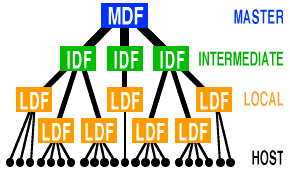
|
The MDF contains the main building routers, the ATM Switch, and building-wide network concentrators (such as FDDI). It also houses the building fileservers and services machines such as the primary DNS server, the printserver, the Mail-hub and WWW servers. The MDF is located on the Lower Level, near the front elevator, in E15-XXX.
The IDFs, located on each floor in E15-2XX, 3XX and 4XX, serve as cross-patch points--they connect the main vetrtical trunk to the horizontal branches to the labs. They also contain direct runs ("home runs") to office areas which are not served by any LDF. The IDF also contains concentrators and other network gear.
The LDFs are the hot-spot of the Lab's dynamic network, for here live the direct connections to the majority of networked hosts in the building. Each host sends a pair of fibers to the LDF, which is typically patched into a concentrator in that frame.
Each time a machine is moved, it's network connection must be re-patched; the LDF is where these patches are made. The modularity and scalar construction of our network infrastructure make this a snap.
| In practice, there are various exceptions to the typical hookup-- our network containes networks other than Ethernet, such as Fast-Ethernet, FDDI, ATM, and experimental hardware. Hosts on a single subnet get wander into different parts of the building. Hosts in different labs need private high-speed connections . . . but it all gets connected, because of the flexibility of our infrastructure. | 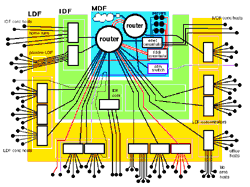
|
| [bigger image, 55k] |
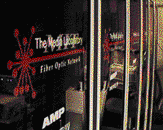
The MDF |

An IDF |
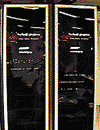
An LDF |
| Master Distribution Frame
The MDF is the central network hub of the entire Media Lab. It is
located in E15-040, and houses all the main routers, switches,
lab-wide servers and other equipment which serves the Laboratory as a
whole.
|
Intermediate Distribution Frame
An IDF connects all the fiber on one floor to the vertical fiber backbone. There are three IDFs, located in E15-240T, E15-340T, and E15-440T, in what are sometimes called 'the telephone closets'. IDFs contain Patch Panels and some Concentrators. |
Local Distribution Frame
Local Distribution Frames are the hub for a Laboratory area and the office suites surrounding that lab. They are located in single- or double-wide equipment racks, and contain the Patch Panels and Concentrators for that area. |
Fiber Optic CableThis is just one tiny glimpse of over 20 miles of fiber cabling installed at the Media Lab, an ultra-dense infrastructure with over 250 TOTAL MILES of glass fiber in one building. |
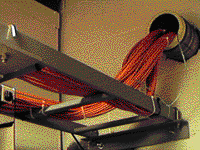 |
Patch PanelThe ST-connector based Patch Panel is the standard device by which all network connections at the Media Lab are made. Patch Panels are located in each Local Distribution Frame (LDF), as well as each IDF and the MDF. |
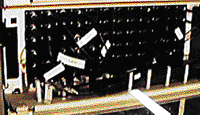 |
These panels typically hold 72 ST-type couplers, which allow dynamic reconfiguration of the installed fiber plant simply by plugging in a patch cable. See Network Hookups for more information on using Patch Panels.
Wall BoxFIBER NETWORK OUTLET This is the standard Fiber Network Outlet for offices at the Media Lab. It provides 3 to 6 fiber network ports, each with two ST-style couplers. It's label documents what LDF Patch Panel it is connected to, and the Port-IDs of each coupler. |
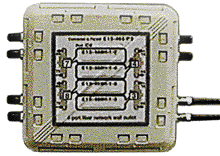 |
Drop Box (SMO style)FIBER NETWORK OUTLET This is the standard Fiber Network Outlet for Lab Areas within the Media Lab. It provides 4 or 6 fiber network ports, each with two ST-style couplers. The Drop Box is deployed in cable trays and under raised floors in open areas where there are no walls to attach wall outlets to. The Drop Box's label documents what LDF Patch Panel it is connected to, and the Port-IDs of each coupler. |
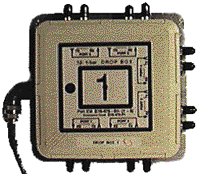 |
Drop Box (In-Line style)FIBER NETWORK OUTLET This is the updated Fiber Network Outlet for Lab Areas within the Media Lab. It provides 4 or 6 fiber network ports, each with two ST-style couplers. The Drop Box is deployed in cable trays and under raised floors in open areas where there are no walls to attach wall outlets to. The Drop Box's label documents what LDF Patch Panel it is connected to, and the Port-IDs of each coupler. |
 |
MIT | The Media Lab | NeCSys | The Network | Structure / Devices / Connectors / Hookups
Comments or suggestions? Fill out a comment form.